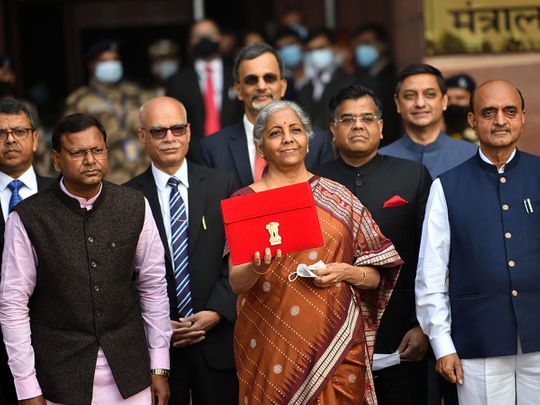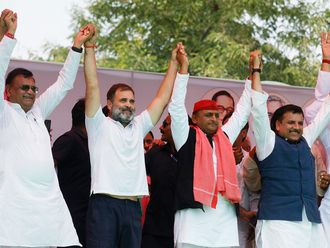
In 2022 if you ask any sensible Indian what’s the most complex issue before the nation, they would say: unemployed youth. In political debates on TV channels, “unemployment” is turning into a highly political subject.
Just before this year’s union budget was presented, there were clashes in Patna and Allahabad between job aspirants who applied for positions in the Indian Railways and local police.
According to the Ministry of Railways account, the employment process — that started in 2019 for 140,000 jobs in Indian Railways — attracted more than 20 million applicants.
Those who were agitating had applied for non-technical jobs that would give them a monthly salary of Rs20,000 to Rs35,000. When some students felt that exams taken in 2020 were allegedly rigged, they started damaging railway properties. On Jan. 25 the police used excessive force against them, injuring many young aspirants. The event became national news.
In the backdrop of this event, finance minister Nirmala Sitharaman presented her fourth budget in the Indian parliament. She noted that the vision of “Atmanirbhar Bharat” (self-reliant India) has the potential to create 6 million new jobs.
Sitharaman also spoke about jobs under GatiShakti programme, identified with Prime Minister Narendra Modi’s development vision that aims to expedite the development of highways, ports, railways, airports, logistics, waterways and infrastructure. She said these united efforts will lead a “to huge job and entrepreneurial opportunities for all, especially the youth.”
Handling the job market
The finance minister spoke about additional credit facility for Micro and Small Enterprises and digital systems that assist sustainable development, further expanding employment opportunities.
However, this was not enough to satisfy the critics who thought the focus should have been only on generation of jobs and not merely on some long term plans — for next 25 years — under the label of “Amrit Kaal.”
Soon after the budget speech, former finance minister P. Chidambaram said, “In the last two years, millions of jobs have been lost, some perhaps forever.”
He added, “The unemployment rates have reached 8.2 per cent for urban and 5.8 per cent for rural workers. After the budget was presented ... we asked ourselves what has the budget done to address any of these grave challenges. The blunt answer is nothing.”
Actually it’s not the case.
In India, opinions are seriously divided over how to handle the job market.
Modi government believes that public investment into building roads, ports and airports will create jobs by employing labour on the massive scale.
And, in turn, the high level of connectivity and better access to markets will “crowd-in” private investments that would help set up factories, boost manufacturing and create further employment.
To walk the talk, Sitharaman has stepped up capital expenditure sharply by 35.4 per cent from 5.54 lakh crore in the current year to 7.50 lakh crore in 2022-23. It’s a historic level of rise.
Tightening the belt
This economic conviction of the government to go for capital expenditure and build permanent infrastructure and not dole out populist projects giving immediate relief was targeted by Chidambaram when he said that in the budget, “there is not a word for those who lost their jobs; not a word about creating job. By any standard, the budget speech was the most capitalist speech ever read by a Finance Minister.”
It appears that the critics of PM Modi want employment generation right now.
Mahesh Vyas, CEO of Centre for Monitoring Indian Economy says, “The increase in the capex will have a limited impact on job market. Even if government actually spends what has been promised, it won’t make a big difference because demand is low and the private investment is low too. Without generating demand, you can’t attract private investment. Without private investment, you can’t get permanent jobs that offer life-time security.”
These two fundamentally differing approach is behind the politics over the job situation. Even Rashtriya Swayamsevak Sangh (RSS) outfit, Swadeshi Jagran Manch, has complained that the budget is, “good for growth but lacks push for employment.”
People’s huge interest in the issue of employment is so high that after the budget when question was asked in Hindi to Sitharaman, “What happened to the 20 million jobs that were promised?”
The clip of this question and Sitharaman’s response, when posted by a media house, got 4 million views on Facebook in less than 12 hours.
Vyas, who monitors employment situation on weekly basis argues, "The work from Mahatma Gandhi National Rural Employment Guarantee Act (MGNREGA) project is not job, similarly labourers engaged in building roads or airports lose work as the project is completed. People look forward to real jobs. That’s possible only if private investment builds new factories. But, when existing factories capacity utilisation is 60% how will private investment “crowd-in”? In this budget demand side isn’t repaired.”
Professor Shamika Ravi, former member of Economic Advisory Council to Prime Minister says, “It’s a political risk. The government has decided to tighten the belt. While going for the strategy for long-term economic growth, the trade-off is clearly in terms of immediate consumption and demand support.”
Ravi says global data suggests that the capital expenditure does have a multiplier effect. The revenue expenditure on the MGNREGA type of project has much less impact on economic activities.
Many observers are surprised that in spite of the budget coming during the election in five states including Uttar Pradesh where job market is critical, Modi decided to keep the budget apolitical.
Shramika Ravi says, “In fact, youth of UP have suffered a lot more than average Indians during pandemic. Indian youth earnings declined around 20% but UP youth lost 30% of their earnings since the lockdown.”
Ila Patnaik, economist and co-author of the book The Rise of the BJP: The Making of the World’s Largest Political Party, thinks, “The budget effectively starts from April 1. By then the five assembly elections will be over. The strategy seems to be this: spend on infrastructure now and save few ideas for the budgets closer to 2024.”
Most BJP leaders I talked to note that Modi never goes for the populist budget. “His budgets are pragmatic and within the box,” one leading BJP leader confided.
Adds Prof Ravi, “Budget 2022-23 is a calculated risk. They are banking on schemes like PM-Awas Yojana and ‘Har-Ghar-Nal’ to fetch them votes.”












